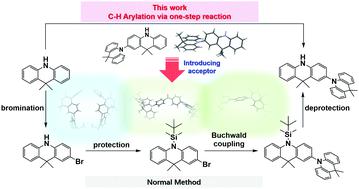当前位置:
X-MOL 学术
›
J. Mater. Chem. C
›
论文详情
Our official English website, www.x-mol.net, welcomes your
feedback! (Note: you will need to create a separate account there.)
A novel donor moiety 9,9,9′9′-tetramethyl-9,9′10,10′-tetrahydro-2,10′-biacridine via one-pot C–H arylation for TADF emitters and their application in highly efficient solution-processable OLEDs
Journal of Materials Chemistry C ( IF 5.7 ) Pub Date : 2020-05-18 , DOI: 10.1039/d0tc01612h Yuchao Liu 1, 2, 3, 4, 5 , Zheng Yin 1, 2, 3, 4, 5 , Xiangbing Wang 1, 2, 3, 4, 5 , Etienne Baranoff 6, 7, 8, 9 , Di Zhou 1, 2, 3, 4, 5 , Kai Zhang 1, 2, 3, 4, 5 , Zhongjie Ren 10, 11, 12, 13, 14 , Shengyue Wang 1, 2, 3, 4, 5 , Weiguo Zhu 1, 2, 3, 4, 5 , Yafei Wang 1, 2, 3, 4, 5
Journal of Materials Chemistry C ( IF 5.7 ) Pub Date : 2020-05-18 , DOI: 10.1039/d0tc01612h Yuchao Liu 1, 2, 3, 4, 5 , Zheng Yin 1, 2, 3, 4, 5 , Xiangbing Wang 1, 2, 3, 4, 5 , Etienne Baranoff 6, 7, 8, 9 , Di Zhou 1, 2, 3, 4, 5 , Kai Zhang 1, 2, 3, 4, 5 , Zhongjie Ren 10, 11, 12, 13, 14 , Shengyue Wang 1, 2, 3, 4, 5 , Weiguo Zhu 1, 2, 3, 4, 5 , Yafei Wang 1, 2, 3, 4, 5
Affiliation

|
9,10-Dihydroacridine is a very popular donor unit for the construction of thermally activated delayed fluorescence (TADF) molecules due to its good electron-donating properties and potential for chemical modifications. However, the functionalization of the 2/7-positions of the acridine unit has rarely been explored. In this contribution, the novel donor moiety 9,9,9′9′-tetramethyl-9,9′10,10′-tetrahydro-2,10′-biacridine (BDMAc) was prepared via a one-pot C–H arylation procedure. Different acceptor fragments, diphenylsulfone (DPS), benzophenone (BPO) and 1,3,5-triazine (TRZ), were then introduced to synthesize three donor–acceptor molecules: DPS-BDMAc, BPO-BDMAc and TRZ-BDMAc. Single crystal X-ray diffraction and theoretical calculations show that these molecules possess twisted molecular geometries and small energy gaps between the singlet and triplet excited states. All molecules exhibit TADF properties with emission peaks between 480–600 nm in both solution and solid states, along with a high emission efficiency of 69–89% in the solid state. Solution-processed organic light-emitting diodes (OLEDs) based on these molecules were prepared with 25 wt% dopant concentration. Although the devices showed efficiency roll-off, a promising maximum EQE of ∼23% and a luminance of 7173 cd m−2 were obtained for the BPO-BDMAc-based device. This research demonstrates the potential of this novel acridine group for designing TADF molecules for efficient solution-processable OLEDs.
中文翻译:

一锅CH-芳基化的新型供体9,9,9'9'-四甲基-9,9'10,10'-四氢-2,10'-二cr啶及其在高效溶液中的应用可加工的OLED
9,10-二氢ac啶因其良好的供电子性能和化学修饰潜力,是用于构建热活化延迟荧光(TADF)分子的非常受欢迎的供体单元。然而,很少研究a啶单元的2/7位的功能化。在该贡献中,通过以下方法制备了新的供体部分9,9,9'9'-四甲基-9,9'10,10'-四氢-2,10'-二bia啶(BDMAc)一锅C–H芳基化程序。然后引入不同的受体片段,二苯砜(DPS),二苯甲酮(BPO)和1,3,5-三嗪(TRZ)来合成三个供体-受体分子:DPS-BDMAc,BPO-BDMAc和TRZ-BDMAc。单晶X射线衍射和理论计算表明,这些分子具有扭曲的分子几何结构,并且在单重态和三重态激发态之间的能隙较小。所有分子均表现出TADF特性,在溶液和固态下均具有480-600 nm的发射峰,在固态下的发射效率高达69-89%。基于这些分子的溶液处理的有机发光二极管(OLED)的掺杂浓度为25 wt%。尽管这些器件显示出效率下降,但有希望的最大EQE约为23%,亮度为7173 cd m对于基于BPO-BDMAc的设备,获得了-2。这项研究证明了这种新型a啶基在设计TADF分子以用于有效的溶液可加工OLED方面的潜力。
更新日期:2020-07-09
中文翻译:

一锅CH-芳基化的新型供体9,9,9'9'-四甲基-9,9'10,10'-四氢-2,10'-二cr啶及其在高效溶液中的应用可加工的OLED
9,10-二氢ac啶因其良好的供电子性能和化学修饰潜力,是用于构建热活化延迟荧光(TADF)分子的非常受欢迎的供体单元。然而,很少研究a啶单元的2/7位的功能化。在该贡献中,通过以下方法制备了新的供体部分9,9,9'9'-四甲基-9,9'10,10'-四氢-2,10'-二bia啶(BDMAc)一锅C–H芳基化程序。然后引入不同的受体片段,二苯砜(DPS),二苯甲酮(BPO)和1,3,5-三嗪(TRZ)来合成三个供体-受体分子:DPS-BDMAc,BPO-BDMAc和TRZ-BDMAc。单晶X射线衍射和理论计算表明,这些分子具有扭曲的分子几何结构,并且在单重态和三重态激发态之间的能隙较小。所有分子均表现出TADF特性,在溶液和固态下均具有480-600 nm的发射峰,在固态下的发射效率高达69-89%。基于这些分子的溶液处理的有机发光二极管(OLED)的掺杂浓度为25 wt%。尽管这些器件显示出效率下降,但有希望的最大EQE约为23%,亮度为7173 cd m对于基于BPO-BDMAc的设备,获得了-2。这项研究证明了这种新型a啶基在设计TADF分子以用于有效的溶液可加工OLED方面的潜力。


















































 京公网安备 11010802027423号
京公网安备 11010802027423号